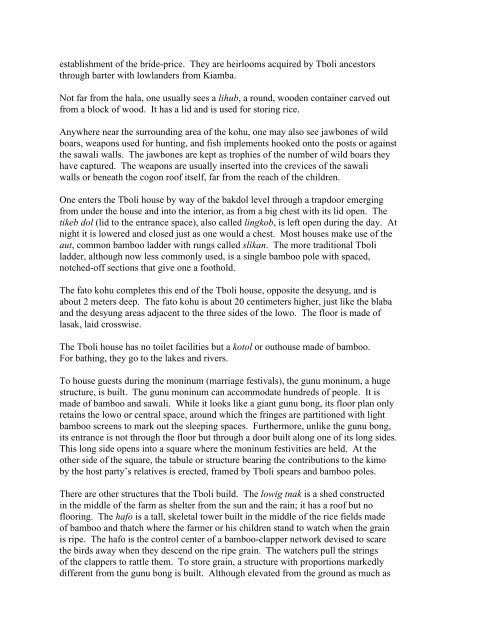The Tboli, also known as T'boli, Tiboli, and Tagabili, are an old ...
The Tboli, also known as T'boli, Tiboli, and Tagabili, are an old ...
The Tboli, also known as T'boli, Tiboli, and Tagabili, are an old ...
Create successful ePaper yourself
Turn your PDF publications into a flip-book with our unique Google optimized e-Paper software.
establishment of the bride-price. <strong>The</strong>y <strong>are</strong> heirlooms acquired by <strong>Tboli</strong> <strong>an</strong>cestors<br />
through barter with lowl<strong><strong>an</strong>d</strong>ers from Kiamba.<br />
Not far from the hala, one usually sees a lihub, a round, wooden container carved out<br />
from a block of wood. It h<strong>as</strong> a lid <strong><strong>an</strong>d</strong> is used for storing rice.<br />
Anywhere near the surrounding <strong>are</strong>a of the kohu, one may <strong>also</strong> see jawbones of wild<br />
boars, weapons used for hunting, <strong><strong>an</strong>d</strong> fish implements hooked onto the posts or against<br />
the sawali walls. <strong>The</strong> jawbones <strong>are</strong> kept <strong>as</strong> trophies of the number of wild boars they<br />
have captured. <strong>The</strong> weapons <strong>are</strong> usually inserted into the crevices of the sawali<br />
walls or beneath the cogon roof itself, far from the reach of the children.<br />
One enters the <strong>Tboli</strong> house by way of the bakdol level through a trapdoor emerging<br />
from under the house <strong><strong>an</strong>d</strong> into the interior, <strong>as</strong> from a big chest with its lid open. <strong>The</strong><br />
tikeb dol (lid to the entr<strong>an</strong>ce space), <strong>also</strong> called lingkob, is left open during the day. At<br />
night it is lowered <strong><strong>an</strong>d</strong> closed just <strong>as</strong> one would a chest. Most houses make use of the<br />
aut, common bamboo ladder with rungs called slik<strong>an</strong>. <strong>The</strong> more traditional <strong>Tboli</strong><br />
ladder, although now less commonly used, is a single bamboo pole with spaced,<br />
notched-off sections that give one a footh<strong>old</strong>.<br />
<strong>The</strong> fato kohu completes this end of the <strong>Tboli</strong> house, opposite the desyung, <strong><strong>an</strong>d</strong> is<br />
about 2 meters deep. <strong>The</strong> fato kohu is about 20 centimeters higher, just like the blaba<br />
<strong><strong>an</strong>d</strong> the desyung <strong>are</strong><strong>as</strong> adjacent to the three sides of the lowo. <strong>The</strong> floor is made of<br />
l<strong>as</strong>ak, laid crosswise.<br />
<strong>The</strong> <strong>Tboli</strong> house h<strong>as</strong> no toilet facilities but a kotol or outhouse made of bamboo.<br />
For bathing, they go to the lakes <strong><strong>an</strong>d</strong> rivers.<br />
To house guests during the moninum (marriage festivals), the gunu moninum, a huge<br />
structure, is built. <strong>The</strong> gunu moninum c<strong>an</strong> accommodate hundreds of people. It is<br />
made of bamboo <strong><strong>an</strong>d</strong> sawali. While it looks like a gi<strong>an</strong>t gunu bong, its floor pl<strong>an</strong> only<br />
retains the lowo or central space, around which the fringes <strong>are</strong> partitioned with light<br />
bamboo screens to mark out the sleeping spaces. Furthermore, unlike the gunu bong,<br />
its entr<strong>an</strong>ce is not through the floor but through a door built along one of its long sides.<br />
This long side opens into a squ<strong>are</strong> where the moninum festivities <strong>are</strong> held. At the<br />
other side of the squ<strong>are</strong>, the tabule or structure bearing the contributions to the kimo<br />
by the host party’s relatives is erected, framed by <strong>Tboli</strong> spears <strong><strong>an</strong>d</strong> bamboo poles.<br />
<strong>The</strong>re <strong>are</strong> other structures that the <strong>Tboli</strong> build. <strong>The</strong> lowig tnak is a shed constructed<br />
in the middle of the farm <strong>as</strong> shelter from the sun <strong><strong>an</strong>d</strong> the rain; it h<strong>as</strong> a roof but no<br />
flooring. <strong>The</strong> hafo is a tall, skeletal tower built in the middle of the rice fields made<br />
of bamboo <strong><strong>an</strong>d</strong> thatch where the farmer or his children st<strong><strong>an</strong>d</strong> to watch when the grain<br />
is ripe. <strong>The</strong> hafo is the control center of a bamboo-clapper network devised to sc<strong>are</strong><br />
the birds away when they descend on the ripe grain. <strong>The</strong> watchers pull the strings<br />
of the clappers to rattle them. To store grain, a structure with proportions markedly<br />
different from the gunu bong is built. Although elevated from the ground <strong>as</strong> much <strong>as</strong>
















